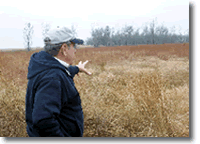
LANDOWNER
INTERVIEWS
Leaving a Legacy through Conservation in the Little Cottonwood Watershed
Click
to hear interview
About
Flooding
About Pheasants
Gary
Rathman
| Roland Richert | Gerald
and Lorrel Riederer | Marvin and
Esther Windschitl

Gerald and Lorrel Riederer have their reasons for enrolling land in a conservation program.
“The 10-acre area I enrolled in CREP sits along the Little Cottonwood River and used to be really good hay meadowland when we had cattle. I liked going to that area of the farm, since it was so serene,” said Gerald. “After we sold the cattle we had no need for the hay, but still needed to provide income. So, about 20 years ago we converted it into a corn and soybean field. Because of flooding, and washing problems, the low bottom ground set us back in the spring. After our retirement from farming our renter faced the same problems so he actually recommended CREP to me.”
Gerald liked the idea of conserving the land and seeing it go back to its natural state while keeping it in the family. “The Riederer farm is a century farm so keeping it in the family was important to us," he said.
Gerald also recently enrolled about 15 acres in a U.S. Department of Agriculture wetlands conservation pilot program. This program, known as the Farmed Wetlands Program (FWP), allowed landowners to enroll small wetland areas and adjacent buffers in the Conservation Reserve Program (CRP) for 10 to 15 years. The program was intended for cropped wetland basins located upland and no bigger than five acres. FWP proved to be a valuable tool for many Brown County farmers since it helped them manage wet areas consistently, while improving water quality and wildlife habitat.
Gerald found out about FWP when the Little Cottonwood River Watershed group and the Natural Resources Conservation Service sent out proposals to eligible landowners. “I really couldn't see any reason not to enroll in the program. Even with tiling, I have always had drainage problems with those areas,” notes Gerald. “In some years I had to wait for the ground to freeze before I could get the corn out. I was going to add more tile, but the idea of being able to square off the field, along with the competitive CRP rental rates, convinced me otherwise.”
When asked what the
site will be like in the future, Gerald replied, “The grasses will
be great for pheasant cover. There was good hunting when I was a kid,
but not anymore. I really miss hearing the crow of a pheasant in the morning.
Hopefully I can help bring that back.”
"The grasses will be great for pheasant cover. I really miss hearing the crow of a pheasant in the morning. Hopefully I can help bring that back."
| landowners | educators | site map |
Brown Nicollet Cottonwood Water Quality Board
322 South Minnesota Avenue | St. Peter, MN 56082 | Phone: 507-934-4140 | Fax: 507-934-8958